Propagating string of hearts can be done so many different ways, it’s easy for even the most inexperienced gardeners. In this post, I’ll explained all the methods you can try, and walk you through exactly how to tackle each one.
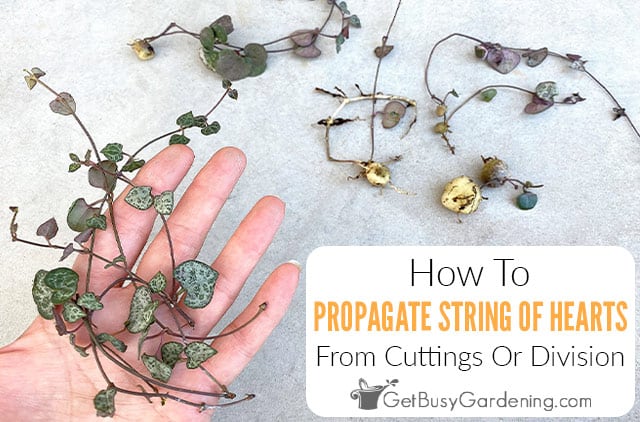
If you want to learn how to create plenty of new baby string of hearts plants to enjoy and share with friends, and have fun doing it too, then this article is for you.
It’s simple to multiply a string of hearts plant, and there are several ways to do it. Experiment with all of the different methods, or choose the one that interests you the most.
My detailed directions below will walk you through all of the techniques, and show you exactly how to propagate your string of hearts.
String Of Hearts Propagation Methods
String of hearts (Ceropegia woodii), also known as “rosary vine” or “chain of hearts”, can be propagated several ways.
Division, cuttings, or seeds are all viable methods to use to multiply them. These techniques are pretty easy, but some take much longer than others.
It doesn’t matter if you have the traditional one, variegated, silver, or pink, every variety can be multiplied using the methods described below.
Related Post: Plant Propagation: A Detailed Guide For Beginners
From Cuttings
Taking cuttings from rosary vines is very easy, and there’s no particular place that’s best. Any vine segment that’s 3-4” long with healthy leaves will work.
Roots will form from the leaf nodes along the stem in either water or soil. So if yours is getting too long and needs a trim, it’s a great time to give it a try.
It’s also possible to use leaf cuttings, but it will take the longest to get a full sized plant this way. Still fun to experiment though!
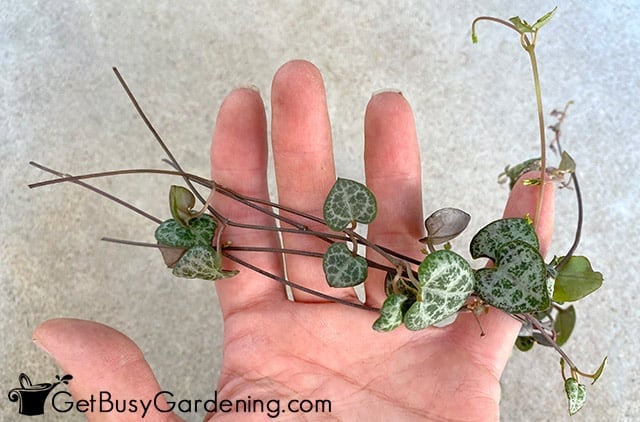
By Division
Division is a good way to quickly propagate string of hearts, and it has a very high success rate. There are two ways to approach it.
The rootball can be divided into large chunks and potted up into separate containers. Or, you can divide each tuber (bulb) and repot them for many new plants.
The tubers are under or along the soil line, or sometimes appear as small yellow, bulbous growths along the stems. Those are called aerial tubers and will take the longest to produce a good-sized plant.
From Seeds
When pollinated, Ceropegia woodii can produce viable seeds that form on feathery white pods after the flowers fade.
They can be harvested and germinated, but this is a very long and tedious method for getting mature plants.
When To Propagate String Of Hearts
The best time to propagate string of hearts using any of these methods is in the early spring or summer.
That’s because their active growth period is during the warmer months, so they will root and produce new starts much faster.
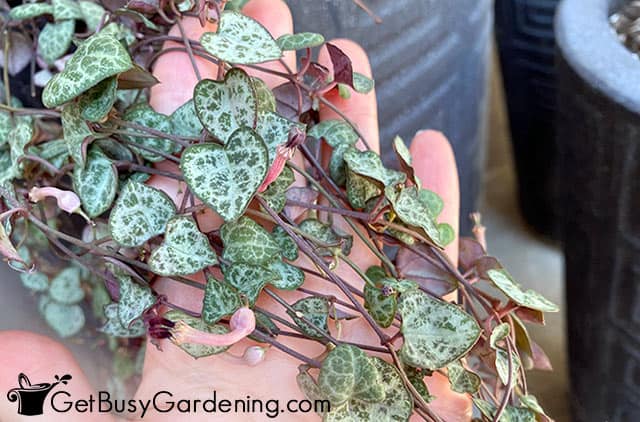
Supplies For Propagating Rosary Vine
Here you’ll find the tools and equipment you’ll need to propagate Ceropegia woodii. The exact items depends on the technique you choose. Take a look at my full list of supplies for more ideas.
- String of hearts cuttings, leaves, or tubers
- Soil medium or water
- Propagation chamber (optional for the soil method)
- Rooting hormone
- Vase or container (if using water)
- Clean sharp precision pruners or micro snips
- Potting mix
- New pot
- Paper clips or pins (optional)
Propagating String Of Hearts From Cuttings
The first thing you need to do to propagate string of hearts is learn to properly take and prepare the cuttings. It’s not difficult, but needs to be done the right way.
How To Cut String Of Hearts For Propagation
Choose a 3-4” section of vine that has healthy leaves attached. Alternatively, you can take one longer segment and cut it into several sections.
Use clean precision pruners or snips to make a straight cut right above the next section of leaf joints.
If you want to try rooting individual leaves, make sure nub of the stem is still attached, or it won’t work.
Otherwise, take a 1-2” section of stem with two leaves attached. These are often called butterfly cuttings.
Preparing The Cuttings For Propagation
Remove all leaves on the bottom two inches of the cutting. There must be at least one exposed node in order for it to work.
You should also snip off the extra empty piece of stem below the bottom node, because it will only rot.
If there are any flowers or buds, pinch them off as well. Bloom development takes energy from the cuttings, and we want them to direct it toward rooting instead.
How To Grow String Of Hearts From Cuttings
With your vine segments prepared, you’re ready to start. Below you’ll find detailed instructions for rooting chain of heart cuttings in either soil or water.
Steps For Rooting Rosary Vine Cuttings In Soil
Propagating rosary vines in soil produces stronger starts fairly quickly, but requires humidity. I recommend purchasing or making a propagation box to help.
Rooting stem cuttings is the easiest, but you can also use vines that are still attached to the mother plant. Below I’ll explain how to do both.
Step 1: Prepare the soil – For best results I recommend using a well-draining medium, like a sandy cactus mix.
You could also make your own by combining equal parts potting soil, perlite or pumice, and coarse sand.
Step 2: Prepare the container – Fill a container or propagation chamber with 3-4” of slightly damp, but not soggy medium.
For cuttings, first make holes 2” into the medium. You can put several into the same container.
If you’re working with vines still attached to the mother plant, place a new pot filled with fresh soil next to it.
Step 3: Apply rooting hormone – Brush the exposed leaf nodes with rooting hormone. You could also dust the vines attached to the mother before laying them over the soil, which will help speed things up.
Step 4: Put them into the container – Place the dusted end into the holes you made, and gently pack the soil around them, ensuring the nodes are under the surface.
For vines still attached, coil them on the top of the new pot, or drape them across it. Gently pin them down so they have constant contact with the surface.
Step 5: Provide humidity – Put the lid on your propagation box, or tent a plastic bag over the top of the pot. Check every few days for excess condensation to avoid mildew.
If you’ve opted to skip the box, mist them every day to keep the top layer of the soil and cuttings just barely damp.
Step 6: Place in indirect light – String of hearts needs plenty of bright light during propagation, but direct sun could bake them. So place them near a sunny window where they will get filtered light.
Warm medium helps to speed things up, so try placing the container on a heat mat if you want them to root faster.
Steps For Rooting String Of Hearts In Water
You can also propagate string of heart cuttings in water. However, the roots are not as hardy as they are when started in soil, and they take much longer to form.
Also, your rosary vines may have a difficult time transitioning to soil after being in water for an extended period of time. So you need to be patient.
Step 1: Fill a jar or vase – Using a clear vase is great so you can easily watch the root development. Fill it with tepid or lukewarm water.
Step 2: Add the cuttings – Ensure at least one leaf node per stem is under the water. You can place several into the same vase, but be sure no leaves are immersed or they will rot.
Step 3: Keep the water clean – Refresh the water if it gets cloudy, or as it evaporates. It should never be brown or stinky, so be sure to remove any rotted pieces if this happens.
Step 4: Wait for 1/2” long roots – Once the roots are at least a 1/2” long, it’s time to pot them up. Don’t leave them in water much longer, or they’ll have a harder time transitioning back to soil.
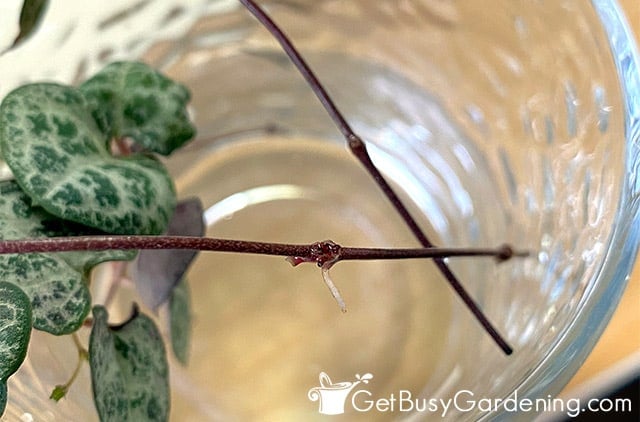
How To Propagate String Of Hearts By Division
Propagating string of hearts by division is easy, and usually the fastest and most successful way to get new plants. It can be approached in a few different ways.
You can divide the rootball, separate individual bulbs in the soil, or use the aerial tubers that form along the vines.
Steps For Dividing The Rootball
The quickest way to create larger, fuller plants is to divide the rootball into sections containing several tubers. Here’s how…
Step 1: Prepare new pots and soil – Choose a clean pot that is proportionate to the size of the division you plan to take, and also has good drainage holes.
Add a layer of well-draining or a general potting mix to the bottom of the new container, and gently pack it down.
Step 2: Gently tease apart rootball – Slide your rosary vine from its pot and work it apart into a few large chunks. It can take some time to untangle the vines and roots, so be gentle and patient with it.
Step 3: Pot them up – Place each new division into a pot at the same depth they were in the original container, and fill in around it with soil.
Gently pack the soil around the roots as you work to fill it so there aren’t any large air pockets. Return them to a bright location that receives indirect light.
Steps For Separating The Tubers (Bulbs)
To create many new chain of heart plants, you can divide the individual tubers. They can appear in several places: underneath or on top of the soil, or as aerial tubers along the vines.
The process is almost the same for each, but aerial tubers will need to root before you see new stem growth.

Step 1: Separate the tubers – For bulbs in or on top of the soil, gently divide them out. They will likely have roots attached, but it’s not required.
For aerial tubers, snip just above them on the vine. Don’t remove any stems or leaves from the bulbs, but if they break off, it will still work.
Step 2: Bury them halfway – Nestle the bottom half of each tuber into the soil. Make sure to bury the side that has roots.
For aerial bulbs, new roots will form from the buried section. If there are any vines or leaves still attached, position them so they are above the soil line.
Step 3: Mist the soil – Keep the top layer where the tuber is buried just barely damp with occasional misting. Don’t let it dry out completely, but also don’t wet it too much or they can rot.
Step 4: Place in bright, warm location – They need bright light and plenty of warmth in order to root, but avoid direct sun or it could burn them. You can try adding bottom heat to get them going faster.
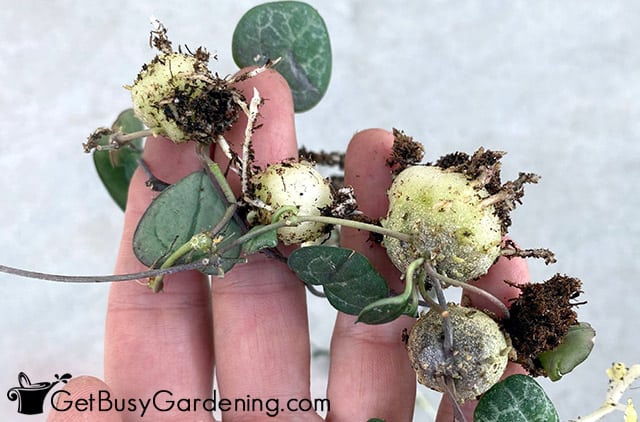
How Long Does It Take String Of Hearts To Root?
String of hearts can start to root very quickly, sometimes in as little as five days. New growth should develop within two to four weeks.
However, it can take a few months for the roots to become mature enough to pot them up, especially in water.
Why Won’t My Rosary Vine Propagate?
If your chain of hearts cuttings aren’t rooting, there are a few common reasons. Usually it’s due to lack of humidity, moisture, heat, or light, or they’re too wet.
Keep the soil consistently moist, but never saturated or soggy. Too much water will cause them to rot.
They don’t like direct sun, but will need lots of bright light, and warmth. Also keep an eye on flower formation, and pinch them off as they appear to encourage rooting.
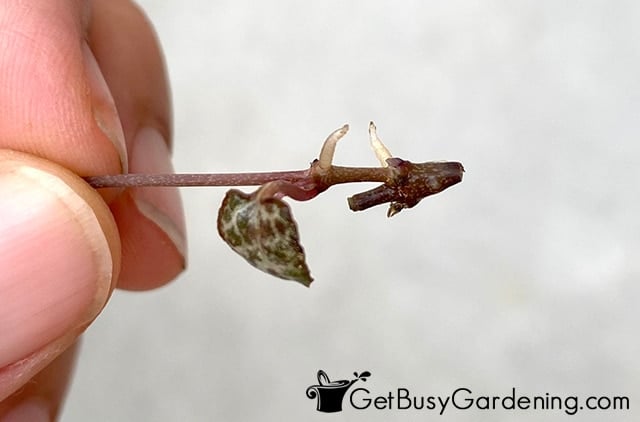
How To Care For A Newly Propagated String Of Hearts
It’s not uncommon for newly propagated string of hearts plants to go through some shock after potting them up.
This is especially true of cuttings left in water for too long. Symptoms of transplant shock are curling, wilting, or yellowing leaves.
Give your brand new rosary vine several days to recover, don’t overwater it, and remove any dried or dead leaves.
Potting Up Rosary Vine Cuttings & Tubers
Once they have developed healthy roots, you can safely pot them up. Use individual containers for each new start, or put several into one to create a fuller plant.
Bury cuttings and tubers so the roots are completely covered, and gently pack the soil around them.
Give them a healthy drink of water, and allow any excess to drain off. Then return them to bright, indirect light.
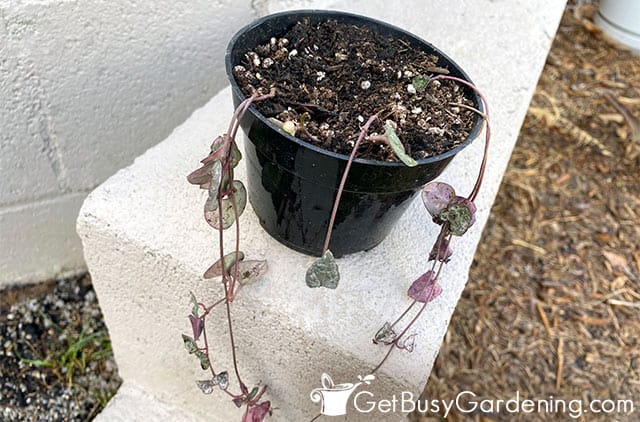
FAQs
Here you’ll find answers to the most commonly asked questions about Ceropegia woodii propagation. If yours isn’t here, please add it to the comments below.
Can you propagate string of hearts in sphagnum moss?
Yes, you can propagate string of hearts in sphagnum moss. Take stem or leaf cuttings and nestle them into pre-moistened sphagnum moss. Cover them with plastic or place them in a propagation chamber until roots develop.
Can you propagate string of hearts with no leaves?
You can propagate a string of hearts with no leaves if you are dividing the tubers. However, stem cuttings require leaves in order to root.
Can you propagate string of hearts leaves?
You can propagate string of hearts leaves, but this is a very slow method that can take several months to produce a new tuber. It’s also the slowest way to get a decent sized plant.
Can you root string of hearts tubers in water?
While it is possible to root string of hearts tubers in water, this method can be tricky. You must keep the bulb above the water line, and never allow it to fully submerge, or it could rot.
Propagating string of hearts is simple, and can be done very successfully with any of these methods. Give it a try, and you’ll see how easy it is to expand your collection, and have lots of new baby plants to share with friends.
Up Next: Learn exactly how to grow and care for your string of hearts plants.
If you want to learn all there is to know about multiplying your favorite plants, then you need my Plant Propagation eBook. It will show you everything you need to know. Download your copy today!
More About Plant Propagation
- How To Propagate Pothos (Devil’s Ivy) Cuttings In Water Or Soil
- How To Propagate Lipstick Plant (Aeschynanthus) In Water Or Soil
- Spider Plant Propagation In Water Or Soil (5 Easy Steps)
- Propagating ZZ Plants From Cuttings Or Division
- How To Mint Plants From Cuttings Step-By-Step
- Propagating Coleus Cuttings In Soil Or Water
- Propagating Ornamental Sweet Potato Vine Cuttings Or Tubers
Share your tips for propagating string of hearts in the comments section below.
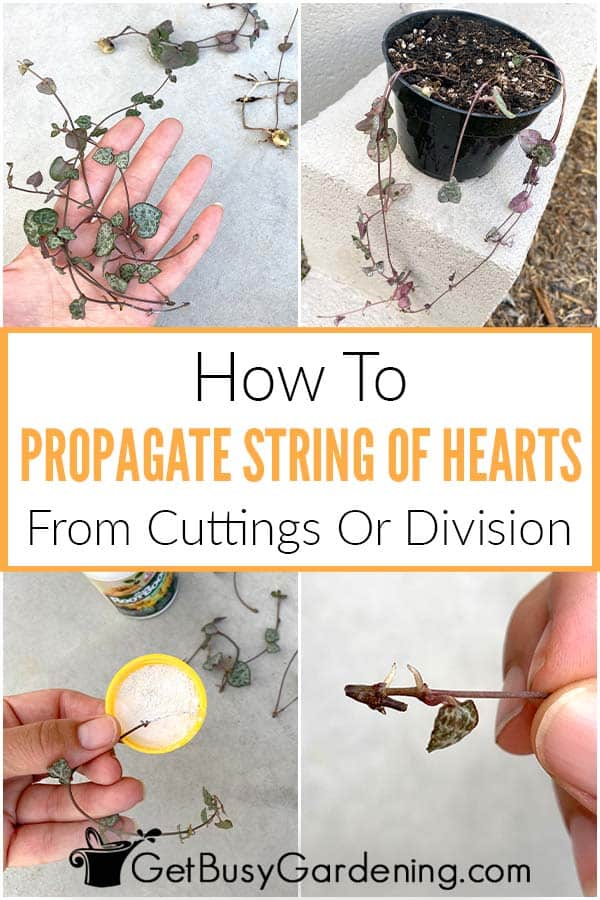
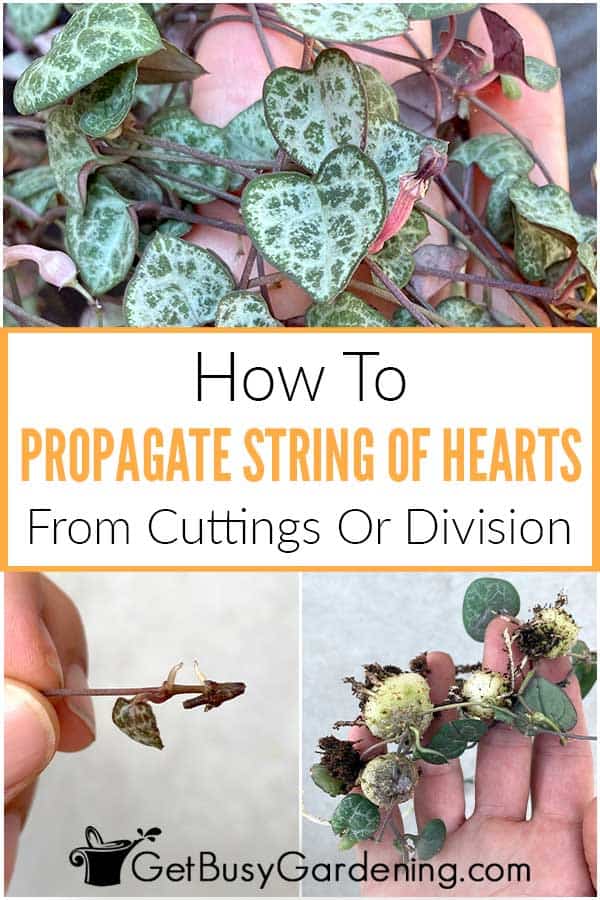
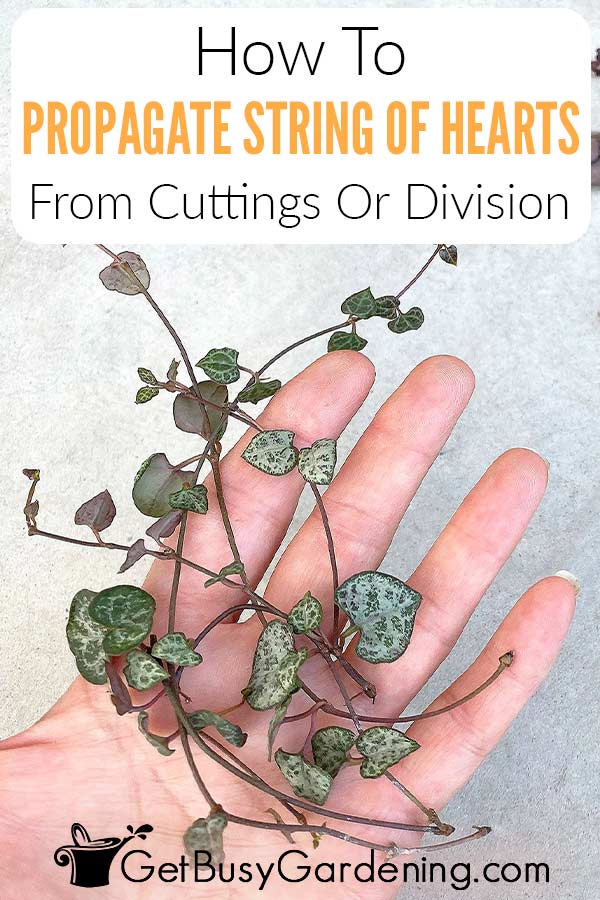

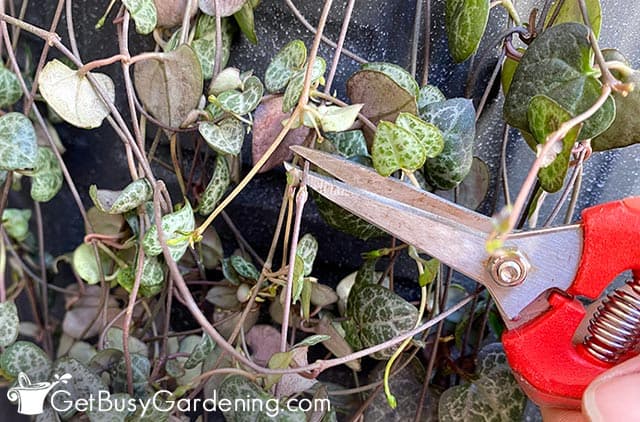
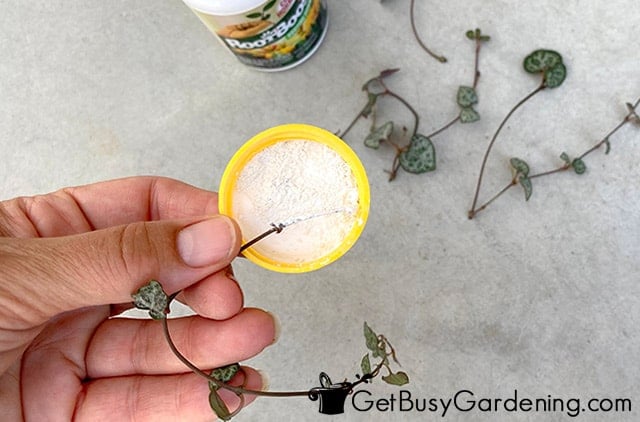


Leave a Reply